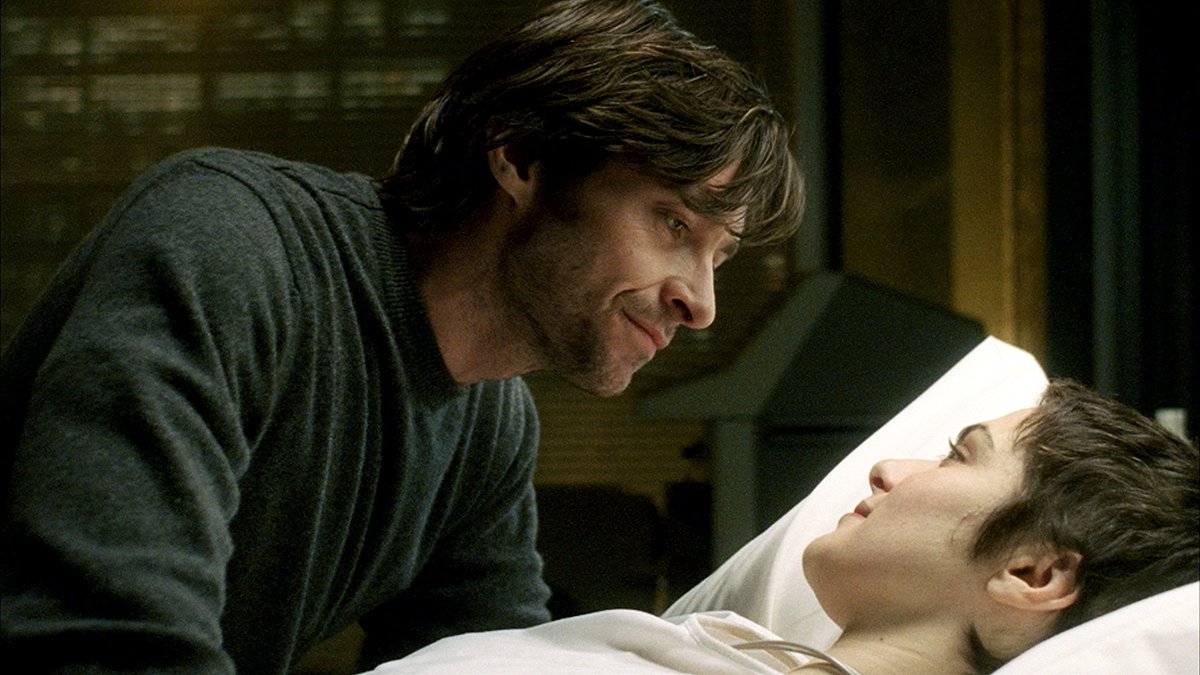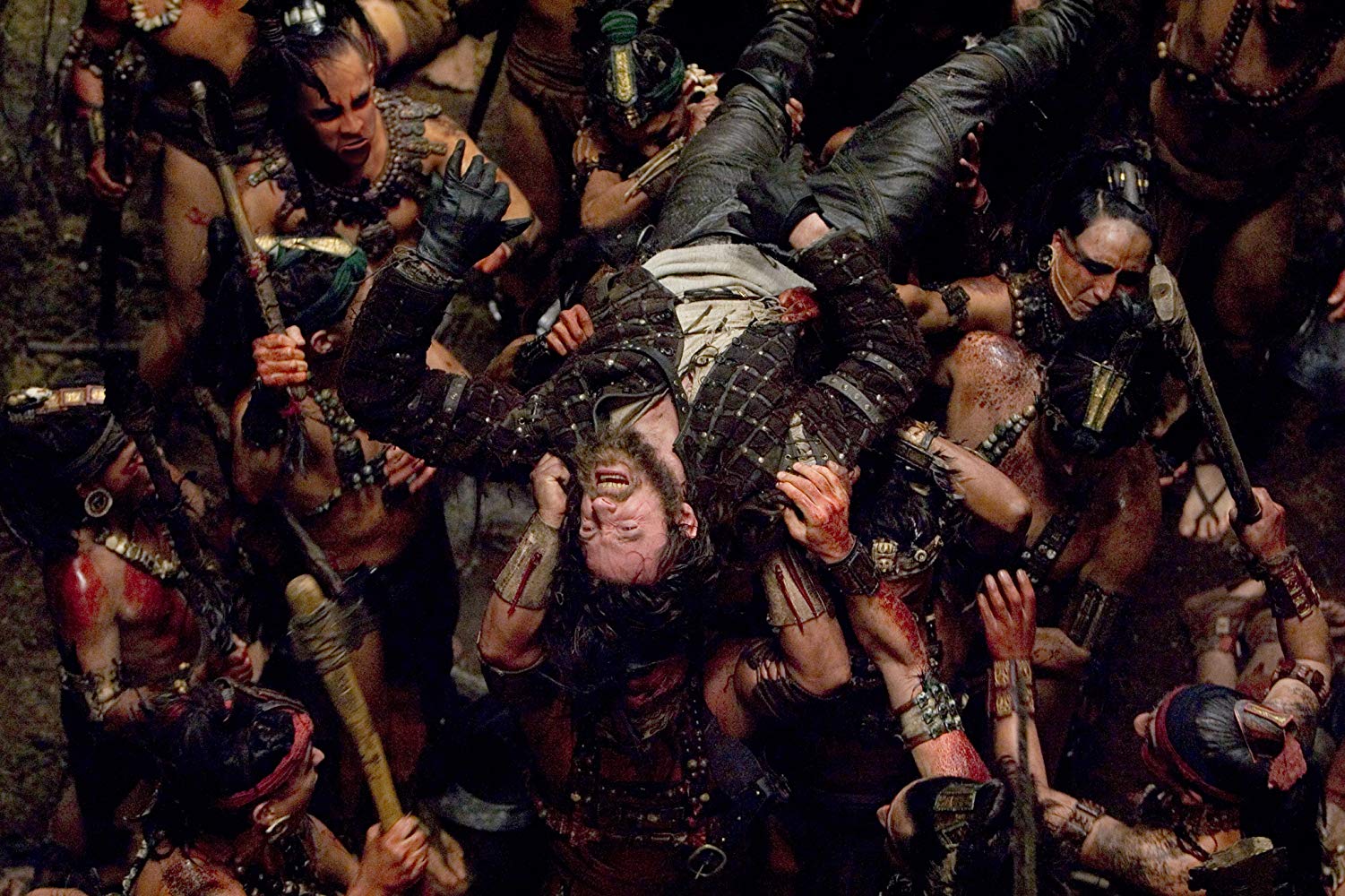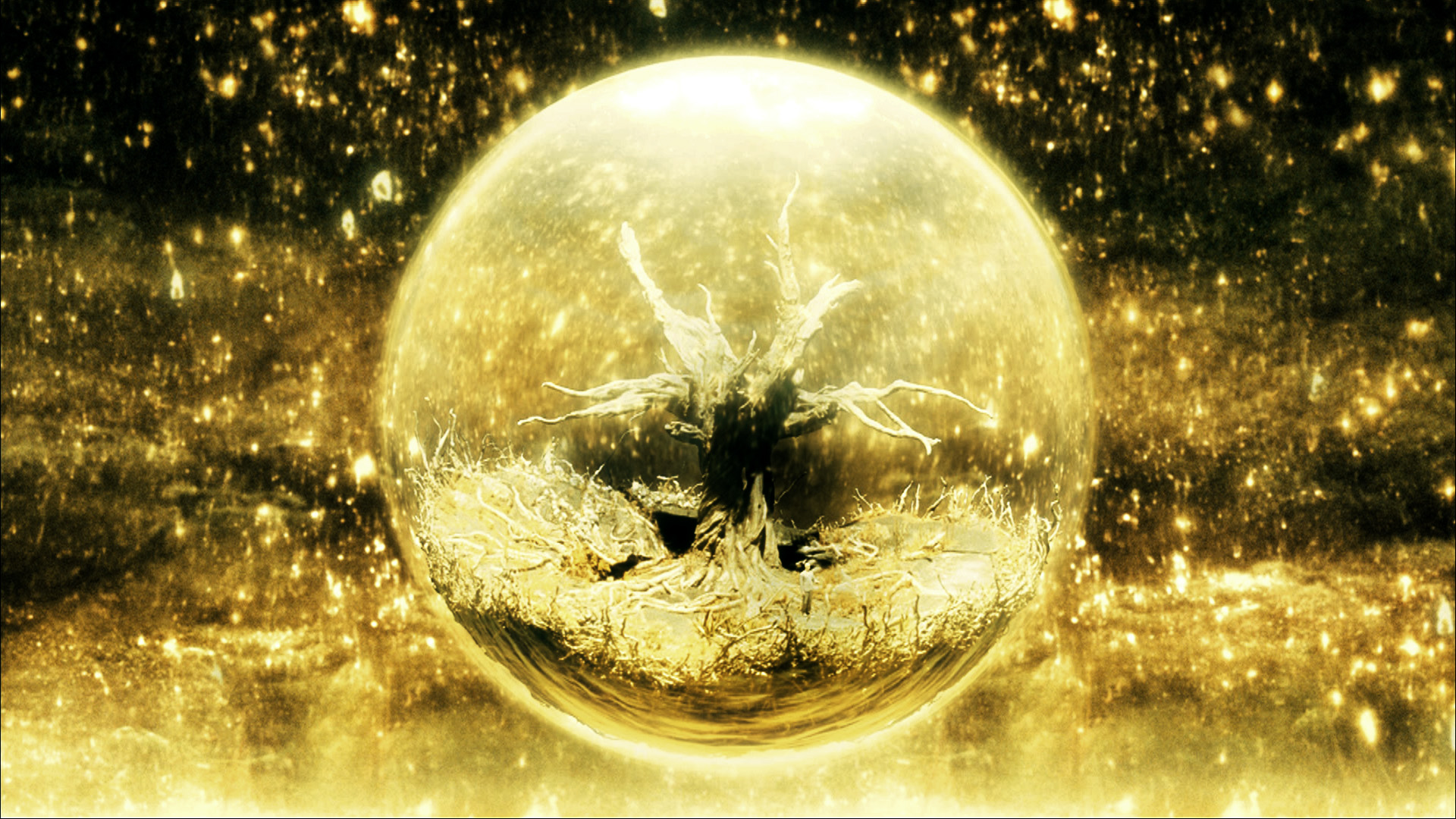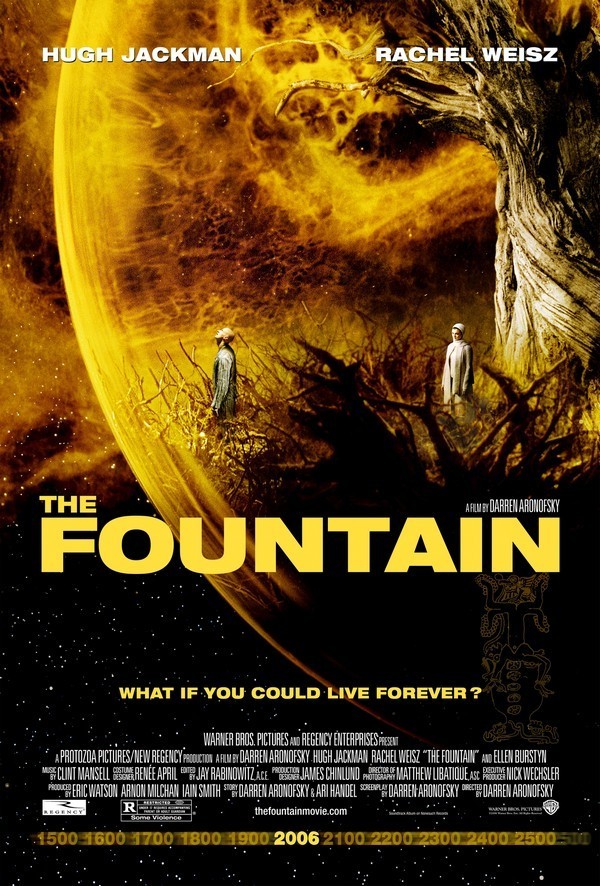USA. 2006.
Crew
Director/Screenplay – Darren Aronofsky, Story – Darren Aronofsky & Ari Handel, Producers – Arnon Milchan, Iain Smith & Eric Watson, Photography – Matthew Libatique, Music – Clint Mansell, Visual Effects – Amalgamated Pixels, Buzz Image Group (Supervisor – Louis Morin), Digital Dimension (Supervisors – Laurent M. Abacassis & Benoit Girard), Intelligent Creatures Inc (Supervisor – Raymond Geiringer), Klon Films (Supervisor – Gunnar Hansen), Look Effects (Supervisor – Henrik Fett), Mokko Studio, Miniatures – New Deal Studio, Special Effects Supervisor – Les Productions de l’Intrigue (Supervisor – Louis Craig), Makeup Effects Supervisor – Adrien Morot, Production Design – James Chinlund. Production Company – Protozoa Pictures/New Regency.
Cast
Hugh Jackman (Tomas/Dr Tom Creo/Tommy), Rachel Weisz (Queen Isabel/Izzi Creo), Ellen Burstyn (Dr Lillian Guzetti), Fernando Hernandez (Lord of Xibalba), Mark Margolis (Father Avila), Cliff Curtis (Captain Ariel), Sean Patrick Thomas (Antonio), Donna Murphy (Betty)
Plot
In the 16th Century, Tomas is given a special commission by Queen Isabel to travel to South America to find a Mayan temple that is reputed to hold a tree that gives eternal life to the one that drinks its sap. Tomas fights his way past hostile natives to finally ascend the temple, only to be dealt a fatal wound by the high priest. In the present-day, Dr Tom Creo’s wife Izzi is dying from cancer. Creo pushes himself to perfect a treatment that will save her and discovers a formula derived from a South American tree that causes a lab monkey to rejuvenate. Izzi leaves Creo an unfinished manuscript for a book entitled ‘The Fountain’ about Tomas’s quest for the tree. In the far future, Tommy travels through space in a bubble spaceship containing a tree that he communes with, seeking Xibalba, the nebula of Mayan myth that is reputed to be the place where dead souls go to be reborn.
Darren Aronofsky is a director that one has admired since his first film Pi (1998), a beautiful, visually dense quest for meaning in mathematics. Aronofsky followed up Pi with the equally dazzling drug addiction film Requiem for a Dream (2000), which came in a series of frenetic editing cuts that tried to inhabit the same kind of mindspace as its addicts. The Fountain was Darren Aronofsky’s third film as director. In between, Aronofsky also co-wrote David Twohy’s subtle submarine ghost story Below (2002) and was at one point announced as director on the merry-go-round of creative talents attached to what eventually emerged as Batman Begins (2005), as well was originally slated to direct the remake of RoboCop (2014). Subsequent to The Fountain, Darren Aronofsky went onto the highly critically acclaimed The Wrestler (2008) and Black Swan (2010), his controversial Biblical adaptation Noah (2014) and the surreal horror film Mother! (2017).
The Fountain had a troubled production history. Darren Aronofksy was due to start shooting in 2004 with Brad Pitt in the Hugh Jackman role(s) and with Cate Blanchett as the love interest. This version had been granted a reported $75 million budget by Warner Brothers and sets were built in Australia before Brad Pitt abruptly pulled out, citing dissatisfaction with the script, and went away to make Troy (2004). Russell Crowe declined the offer to take Brad Pitt’s place and Warner Brothers pulled the plug on the film. Aronofsky turned his original vision of the script into a graphic novel that was published in 2005 by Vertigo Comics.
In late 2005, Aronofksy was able to get a much more scaled down vision of The Fountain off the ground on a budget that had been cut in half ($35 million). This version was filmed in Montreal starring Hugh Jackman and Aronofsky’s fiancee Rachel Weisz. The finished film came out to wildly polarised reviews that swung between calling its beautifully mystical or pretentious claptrap. Characteristic of such polarisation, one of the two premiere screenings at the Venice Film Festival was booed while the other received a standing ovation. Warner Brothers clearly had little faith in the film and did not do much to promote it, although this may well have been a result either of Aronofsky’s vagueness in terms of telling the press what the film was about or the difficulty in trying to summarise such an almost-impossible-to-pigeonhole film.

In Pi, we saw that Darren Aronofsky had a fascination with cosmic mind-states and transcendental thinking. The Fountain revisits that fixated quest for cosmic meaning – there is not too much difference between Sean Gullette’s mathematician obsessively trying to perfect his magic number that unlocks grand cosmic mysteries in Pi and the various incarnations of Hugh Jackman here each obsessively trying to uncover some form of eternal life.
While Pi was a cautionary tale about cosmic knowledge, The Fountain feels like something more akin to 2001: A Space Odyssey (1968) in its journey into communion with higher states of consciousness. (There are a number of other similarities between The Fountain and 2001 – both have a story that takes place in three separate eras spread between the ancient past and the far-flung future; there is the lone astronaut who journeys into the unknown and is consumed in a display of pretty lights; and the end of both, the film moves beyond literal representation of the astronaut’s experience to take place on a level of cryptic symbolism).
Although if anything, you could see The Fountain more as one of the films that came after 2001 like Altered States (1980) and especially Zardoz (1974) that saw a little too much pretentious cosmic meaning in their psychedelic displays of pretty lights. Perhaps you could try imagining The Fountain as a head-on collision between 2001 and the loopy mushroom trip and Carlos Castaneda esotericism of Alejandro Jodorowsky circa El Topo (1970) and The Holy Mountain (1973). (The Fountain also has a number of similarities to The Tree of Life (2011), a film project that Terrence Malick attempted to get off the ground for a number of years).
Certainly, The Fountain is a beautifully made film. Darren Aronofsky photographs everything with a quiet intimacy – much of the film takes place in low lighting and with whispered dialogue. There is a beautiful score played by the Kronos Quartet. Especially lovely are the effects shots of Hugh Jackman’s sphere spaceship drifting through space, outlined against exquisite starscapes and roiling nebulae. Here Darren Aronofsky deliberately chose not to use CGI effects – although some dozen digital effects house are listed on the end credits – and shot chemical patterns and textures instead. The effect is an inordinately lovely one.

At the same time as you admire Darren Aronofky’s visuals, you have to admit that The Fountain is a film where you don’t have a clue as to what it is about. Even the title seems puzzling as there are no fountains in the film. Indeed for a long time going by the snippets of plot information that one could glean and the pictures circulating of Hugh Jackman as a Conquistador, one thought that Aronofksy was making a film about Ponce de Leon’s fabled quest for the Fountain of Youth in the 16th Century.
Hugh Jackman turns up playing three characters in three different eras that are all named some variation on Thomas, while Rachel Weisz turns up as two different characters both named some variant on Isabel. You are not sure if these are the same characters or not. (Critics have offered all manner of interpretation – that Tomas is merely a character in the book; that astronaut Tom is Conquistador Tomas after having taken the immortality drug; that the future scenes are an hallucination of the grief-stricken present-day Tom; or that the different eras are intended as metaphorical representations of states of mind). The various characters seem to experience the same or similar things – they all seem to have the same ring; present-day Hugh Jackman tattoos the lost ring on his finger using the fountain pen that Rachel Weisz gave him and astronaut Jackman also has the tattoo and fountain pen; future Hugh Jackman has visions of the ghost of Rachel Weisz in her hospital bed from the present-day episode.
All of the stories are connected by overlapping reference points that blur in and out of each other – all three stories seem to feature a tree with mystical properties and some quest upon Hugh Jackman’s hero’s part to find an answer to death; Rachel Weisz’s unfinished novel describes the Conquistador era; she makes mention of the star of Xibalba that future Jackman in voyaging to; while there are overlapping visual correlations between the starscapes, the cells in the microscope and the fractral patterns on the hospital floor; of Jackman driving to the hospital in his car as Aronofsky’s camera turns upside down with the same image later replicated with Conquistador Jackman riding his horse towards the citadel; or of future Jackman whispering to the floating tendrils of the tree and he brushing his lips against the hairs of present-day Rachel Weisz’s neck. All of this has a certain fascination as though Darren Aronofsky is telling a film on a subliminal level in the same way that Nicolas Roeg did with Don’t Look Now (1973).

You sit watching this cryptic visual symbolism and wait for Darren Aronofsky to suddenly bring it together in a way that floors you – but are still waiting when the film ends. It all arrives at some kind of transcendent breakthrough where the barriers between the various eras appear to break down. The Mayan priest stabs Conquistador Jackman but then reels in amazement thinking him the First Father that birthed the Tree of Life; Conquistador Jackman drinks of the tree’s sap but then collapses and starts to sprout foliage from inside his body just like The First Father is said to have done; future Jackman exits the spaceship floating in a lotus position and enters the detonating supernova of the Xibalba nebula and then appears as a glowing Buddha figure before his Conquistador self and the high priest. Some kind of mystical breakthrough has clearly been achieved but quite what is a scratch of the head.
Darren Aronofsky would clearly like us to think that he has made a profound work about obsession, timeless love and the belief that there is something that lies beyond death but all that he has given us is only New Age mysticism of the most shameless order. The film only boils down to a handful of pseudo-profound soundbite phrases – “Death is a disease and I am going to find the cure,” “Death is the beginning of awe” – and with a series of cryptic symbols substituted for anything of substance.
Indeed, Darren Aronosfky seems to care more his symbolic interplay and mysticism than he does the characters – though the advertising convinces us that we are seeing a love story that transcends time, little of this emerges from the characters and crucially we are never moved by Rachel Weisz’s death in the contemporary episode as we feel we should have been. There is no story – just a series of fragments of half-told dramas hung together by a series of visual interplays and pretensions to profundity.
Still in an era where films are made to market-tested formula and only seen in terms of what has gone before, you have to commend Darren Aronofsky for attracting major names like Brad Pitt, Cate Blanchett and Hugh Jackman, not to mention a sizeable $75 million budget, to a film that doesn’t appear to be about anything or even have a story. On the other hand, you can’t exactly not side with Brad Pitt and Warner Brothers in getting cold feet about such.
(Winner for Best Musical Score, Nominee for Best Cinematography and Best Special Effects at this site’s Best of 2006 Awards).
Trailer here


